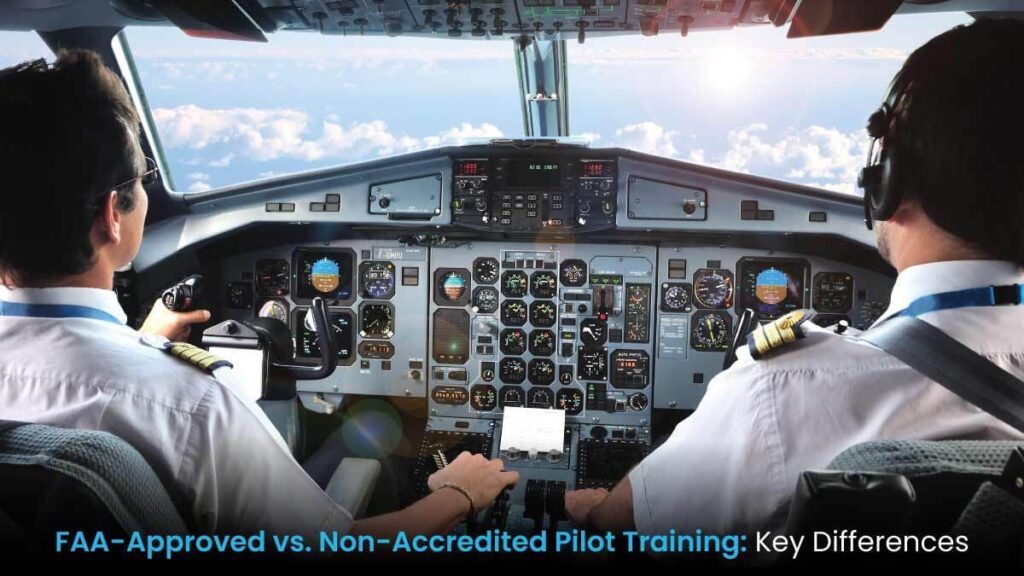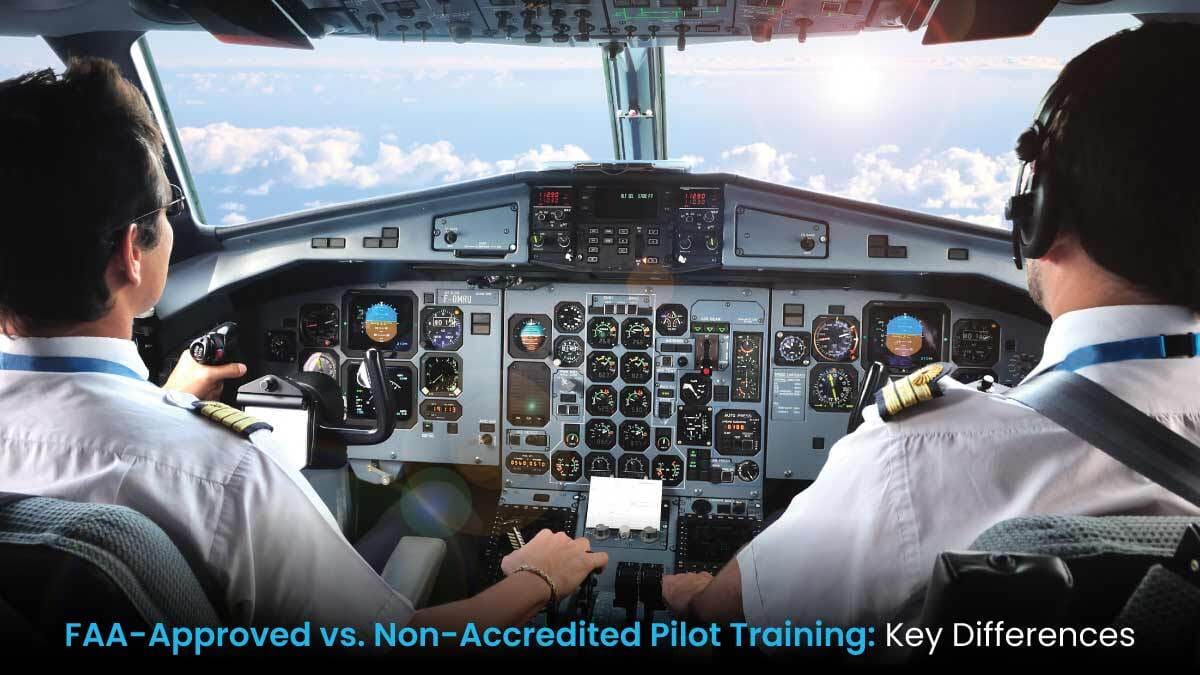
Getting Started: Which Pilot School Should You Pick?
Let’s say you’re eighteen and a plane enthusiast. You begin researching flying schools. A fast track is promised by one Florida school, but it comes with international paperwork and a high cost. Another, right here in India, is more affordable, approved by our national aviation authority, and tailored to Indian airline careers. One can feel confused and distant. The other is familiar, well-structured, and built for success in the Indian skies. So, which one will help you become a pilot?
This blog is here to help you figure that out. If you’re checking out the Insight Aviation’s IndiGo cadet training programme, wondering about IndiGo pilot training fees, or just curious about what it takes to fly, we’ll explain the big differences between FAA-approved airlines training and Non-Accredited Training—especially DGCA-approved programs—in a way that’s easy to understand.
Let’s dive in—no complicated words, just clear info, comparisons, and helpful examples. Ready for takeoff?
What Does “FAA-Approved” Mean?
The FAA (Federal Aviation Administration) manages flying in the United States. If a school is “FAA-approved,” that means it follows rules that are respected in many countries.
You may find this useful if you wish to work outside of India. However, there are obstacles as well, such as relocating overseas, making payments in US dollars, and completing additional procedures to have your license accepted in India later.
Why Some People Pick FAA-Approved Training:
- Accepted by airlines in many countries
- Has clear lessons and rules focused on safety
- Often uses new aircraft and tools
- Can help if you plan to work outside India
But remember: FAA training is in the U.S., so you’ll need a visa, travel plans, and extra paperwork to convert your license for Indian use.
What is Non-Accredited Training? (Let’s Talk About DGCA)
In India, most flight schools are approved by DGCA—our national aviation authority. These schools are designed to help you become a professional pilot in India and meet the local standards set by the government.
Some people call them “non-accredited” just because they’re not approved by international groups like FAA or EASA. But that doesn’t mean they aren’t good. In fact, many top pilots working in India trained at DGCA-approved schools.
Why DGCA-Approved Training Makes Sense:
- Focused on getting you ready to fly for Indian airlines like IndiGo, Air India, and SpiceJet
- No need for license conversion if you want to fly in India
- Easier on your budget—lower tuition and no foreign living costs
- More schools close to home, so you stay near family
- Designed for Indian exam systems and airline requirements
Clearing Up Some Confusion:
- “It’s not globally approved, so it’s not good.” – Not true! DGCA is a respected authority in India, and their standards are solid.
- “It’s cheaper, so it must be low quality.” – Many DGCA schools have great equipment, strong instructors, and high pass rates. You just have to pick the right one.
- “You have to go abroad to succeed.” – Plenty of successful pilots fly for IndiGo and other big airlines after training right here in India.
DGCA vs. FAA: What’s the Real Difference?
Here’s a simple chart to help you compare:
| What You Get | DGCA (India) | FAA (USA) |
| Best For | Flying in India | Flying internationally |
| License Validity | In India (no conversion needed) | Needs conversion for India |
| Time to Finish | About 18–24 months | About 12–18 months |
| Cost | ₹25–40 lakh | ₹35–50 lakh+ |
| Job Opportunities | High for Indian airlines | Good abroad, but it needs a license switch here |
| Equipment & Training | Varies, but many schools have great gear | Often, modern and standard |
| Classmates | Mostly Indian students | International mix |
Wondering about IndiGo pilot training fees? They usually range from ₹40–85 lakh depending on where and how you train. With DGCA-approved schools, you may avoid many extra costs like visa fees, housing abroad, and conversion exams.
Why DGCA Might Be the Right Pick for You
DGCA-approved training is a smart, budget-friendly choice for many Indian students.
Pick DGCA Training If You:
- Plan to fly for Indian airlines
- Want to avoid visa hassles and stay closer to home
- Need to keep training costs lower
- Prefer to learn in an Indian setting that fits your lifestyle
- Want a direct, recognized path to a local pilot job
Pick FAA-Approved If You:
- Want to work abroad in the future
- Are okay with the higher costs and paperwork
- Are ready to live and study in the U.S.
Quick Tip: Ask yourself: “Where do I want to be in five years?” If the answer is flying in India, DGCA training might be the smartest way to get there.
Still confused? Talk to pilot students, visit schools, and ask about placement rates. The more you know, the better your choice.
What Does Insight Aviation Do?
Insight Aviation works with top flying schools and helps students through the whole journey—from picking a programme to getting ready for airline interviews.
If you’re asking “when will IndiGo cadet program start again?” or thinking about joining the IndiGo flying school, Insight Aviation can help you stay updated and pick the right path.
They help you:
- Compare FAA-approved and DGCA-approved programmes
- Understand costs, timelines, and paperwork
- Find schools that fit your budget and goals
- Get help with airline interview prep and license details
Insight makes the process easier, so you can focus on learning to fly.
Also Read: Why Does Insight Aviation Stand Out in Pilot Training?
Last Call: Your Future Is in the Skies
No matter what route you choose, you can still become a great pilot. Whether it’s FAA-approved or DGCA-approved, both paths can lead to exciting careers.
If you want to fly for Indian airlines, train close to home, and save money, DGCA training is a reliable and smart choice. It gives you everything you need to succeed without the added stress of moving abroad or converting licenses.
Stay focused, ask questions, and pick the school that fits your dream.
FAQs
Q: What is FAA-approved pilot training?
A: It’s training at a school certified by the FAA (Federal Aviation Administration) to follow strict safety and quality standards.
Q: What does “non-accredited” pilot training mean?
A: It means the school is not FAA-certified, but it can still offer private training under general rules.
Q: Which one is better than the other?
A: FAA-approved training is more structured and ideal for serious, career-focused pilots. Non-accredited is more flexible but less recognized.
Q: Will my license be valid if I train at a non-accredited school?
A: Yes, your license can still be valid if you meet FAA testing and flying requirements.
Q: Do FAA-approved schools help with faster training?
A: Yes, they often offer faster paths and more organized programs, especially for commercial licenses.
Q: Are FAA-approved schools more expensive?
A: Usually yes, because they provide more structure, better facilities, and certified instructors.
Q: Which type of training is better for career pilots?
A: FAA-approved training is better if you want to become a commercial or airline pilot.

